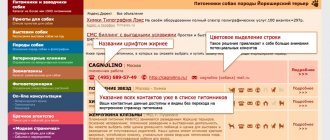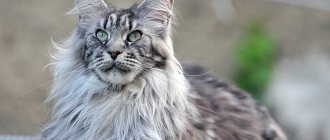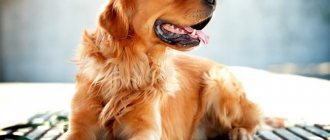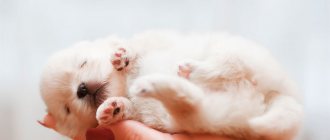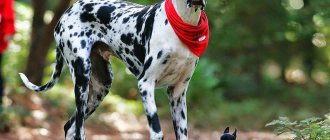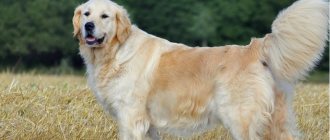The peculiarity of the Golden Retriever breed is noteworthy in that for a long time there was one theory of the origin of this species, but later another one appeared. These dogs have a good disposition and are great friends for people, which is why the breed is so popular today. To understand whether such a breed is suitable for your neighborhood, it is recommended to study the characteristics of the retriever.
History of the origin of the Golden Retriever breed
For some time it was believed that the Golden Retriever was descended from the Russian circus dog. However, in 1952, a new version of the origin was published: according to it, this species was founded by Lord Tweedmouth from Great Britain, who kept the stud book. There he independently recorded each breed of his pets, taking into account the dates of birth and days of mating of individuals from the nursery. The first records dated back to 1835.
In the pedigree you can find the following species:
- Irish Setter;
- water spaniel;
- black curly coated retriever;
- Labrador.
The story goes that while walking around Brighton, Lord Tweedmouth discovered a man repairing shoes with a yellow retriever sitting next to him. The Lord immediately purchased the puppy and a few years later bred him with a water spaniel: 3 puppies were born from this litter. They were bred with dogs of other breeds listed above and in 1889 the first representatives of this dog breed were born.
In 1911, the Golden Retriever breed was officially registered, and since 1930 the species has been officially recognized in America. In Russia, pedigree breeding began in 1989.
It is forbidden:
- Pull anything from the mouth until 6-8 months. – the bite will deteriorate
- Giving sharp bird bones may cause internal bleeding
- Give boiled, sharp bones
- Giving sweets
- Give food hot or from the refrigerator
- Feed from the floor - the dog should have a stand for the bowl. As the puppy grows, the height of the stand should increase.
- The puppy can go down the stairs on his own until he is 4-6 months old. Otherwise, there may be a sprain, subluxation of the paws, etc. Next, you need to make sure that the puppy descends slowly, does not accidentally jump off the stairs, does not try to jump over several steps, etc. This is all necessary so that the dog does not get injured during the descent.
- Stroke the ears - so that the puppy does not float his ears and does not block them.
- Wash your dog often
- Arrange a place for the dog in a draft, on a cement floor, in a bathroom, on a balcony, loggia, etc., in a dark place or in a barn, on a walkway, near a radiator.
- Making the place hard means your elbows will be rubbed.
- Putting a puppy in bed means you can’t kick it out later.
- Punish the dog, swing at it. For this purpose it is better to use a long, thin, strong branch.
- Give your dog potatoes, peas, corn, raw dough (see a doctor immediately), spices.
- Take long walks immediately after eating.
- Putting a harness on the puppy - the front limbs may form incorrectly (turned elbows).
- Allow the puppy to walk on slippery floors (linoleum, parquet, laminate, etc.). Otherwise, there may be a sprain, subluxation of the paws, etc. Temporarily cover such coverings with acceptable material.
- Let them jump from a chair, sofa, armchair. Otherwise, there may be a sprain, subluxation of the paws, etc. Therefore, leaving the puppy alone on the sofa (bed, chair) is also not recommended.
- Children should not ride the dog.
What does a Golden Retriever look like, description of the breed
To better learn about the characteristics of this type of retriever, it is recommended to carefully study the description of the modern Golden Retriever breed. This includes adult size and weight, coat color and type, and possible varieties.
Video about the Golden Retriever breed
Size and weight
The height and weight of the representative is determined by the genetic predisposition of the golden dog. Therefore, do not despair if, according to the parameters of your retriever, he “falls short” of the norm or, on the contrary, exceeds it. Some puppies grow quickly, others grow slowly, the main condition is the good physical condition of the dog and his health.
Experts advise not to overfeed your dog in order to achieve a normal weight, as this will greatly affect its health.
A golden retriever is born weighing up to 3 kg, its height at the withers is about 20 cm. In the first month, puppies of this breed gain from 400 to 800 grams, and add about 3 cm in height. As they develop, by 6 months the weight of the individual ranges from 24 to 26 kg, height at the withers – up to 55 cm; by 10 months, the retriever’s body weighs 30–36 kg, its height is 55–61 cm. The size of an adult dog is characterized by the parameters from the table.
| Bitch | Male | |
| Weight | 25–32 kg | 27–36 kg |
| Height | 50–56 cm | 56–60 cm |
Experts note that pets intended for shows and exhibitions look more voluminous than those considered “working”. From this information, we can conclude that golden retriever females are smaller in height and weight than males. Compared to other breeds, retrievers are considered large dogs.
Color and coat type
Externally, individuals stand out from other types of retrievers: they are active, playful, and have gorgeous coat and color. The Golden Retriever's coat should be straight - no pronounced curls are allowed according to the standard, but slight waves may be present. The undercoat is dense, waterproof, and clearly expressed.
Shedding in retrievers occurs in the autumn and spring seasons.
Wool is considered hypoallergenic, so people with children in the house often get dogs.
Do not confuse the Golden Retriever with the Smooth-Coated Retriever - these are two different types that differ in color. The color of the retriever's coat includes all shades: from golden to beige and cream.
There may be light hairs on the chest, but shades of red are not allowed - this breed is considered not purebred. The dark golden hue also confirms the standard.
Breed varieties
There are three types of retrievers:
- English type. Distributed throughout Australia and Great Britain, it is distinguished by a wide skull, powerful front legs, and the color of this golden retriever is lighter than that of the American type. The height of males is 56–61 cm, and that of females is 51–56 cm. They have a friendly facial expression, a quick-witted character, and a breed with pronounced working traits.
- American type. Characterized by elegance and less muscle development. The American type is easy to recognize - its color is slightly darker than that of the English Golden Retriever. The height of males is 58–61 cm, females – 55–57 cm. To improve the characteristics of the breed, American breeders bring the English type for mating.
- Canadian type. Belongs to a more modern generation of puppies, which is distinguished by a dark coat color. The Canadian variety is a breed combining the English and American types. Males reach a height of 58-63 cm, and females - 55-59 cm, which means that the Canadian Golden Retriever has the tallest height.
Golden Retriever with a cat
Based on these indicators, the breed standard is determined, so when purchasing a pet from a breeder, you should pay attention to the parameters so as not to encounter fraud.
External characteristics of Golden
Many people know what a golden retriever looks like . This is a harmoniously built, slightly stocky, but graceful dog with kind eyes and a wonderful character. The description that distinguishes this breed from Labradors and spaniels indicates the permissible height and weight of a golden retriever. An adult show dog is distinguished by a height at the withers from 56 to 61 cm , and a weight from 26 to 41.5 kg . An adult female should grow to 51-56 cm at the withers, and weigh from 25 to 37 kg. The dog must be measured by placing it on a flat, hard surface with all its limbs supported. The paws should stand straight, without protruding or falling, and the head should be clearly parallel to the floor.
Some flaws and deviations from the standard can be examined in the nursery. To do this, you need to know such parameters as some measurements, height and weight of the golden retriever by month. Typically, breeders sell babies who have reached the age of two months and are already able to exist without a mother. golden retriever puppy whose weight is 7-8 kg and whose height at the withers is about 31 cm will be considered almost ideal. But when choosing a dog, you need to remember that the rate and duration of growth and weight gain varies from person to person, and there may always be room for surprises.
Health and illness
Goldens are often in good health, but if your pet is sick, you should not self-medicate, but rather go to a veterinary clinic. Proper nutrition and good care guarantee a long and fulfilling life, but golden retrievers are not immune to disease. The most common among them are:
- epilepsy;
- von Willebrand disease;
- hip dysplasia;
- retinal dysplasia;
- dermatitis.
Epilepsy in a Golden Retriever is difficult to diagnose; in the early stages there are practically no symptoms. As the disease develops, the pet may go into convulsions - such a dog should not be allowed to breed. Von Willebrand disease is a hemorrhagic disorder. It manifests itself as bleeding gums, nasal discharge, and
genital organs and requires a blood transfusion for the pet.
Hip dysplasia is one of the most common diseases in golden retrievers, so puppies are diagnosed in the first year of life when their skeleton is fully formed.
Retinal dysplasia is characterized by gradual loss of vision, but the disease is quickly curable. Dermatitis in retrievers appears after inflammation and with proper treatment does not cause relapses.
Life expectancy of retrievers
The average lifespan of a retriever is 10–12 years; sometimes there are long-livers who live up to 15 years. The lifespan of a Golden Retriever directly depends on its diet and physical health.
How much should an adult pet weigh?
Labradors grow up to a year, after which they practically do not change. Owners only need to worry about maintaining shape.
Labradors are prone to weight gain, and their diet and physical activity must be strictly controlled . Obese dogs experience heart problems.
Labrador boys weigh differently than girls.
For males, the norm is a weight of 28-36 kilograms; for females, a weight from 25 to 33 kilograms is considered normal..
The attitude of retrievers towards children and others
Due to its character, a retriever will never offend a child, which cannot be said about other representatives of the species. Pets are distinguished by their good disposition, playfulness and joy for life. This is the attitude that is necessary for communicating with children of different ages. Regardless of the dog’s age, they are characterized by the following traits:
- patience and tenderness towards children;
- gets along well with other pets;
- lack of aggression;
- love for people;
- the desire to spend as much time as possible with the owner;
- not inclined to defend or attack, but may bark at strangers;
- the inexhaustible energy of this breed gives rise to a love for various games, especially on the water;
- high level of intelligence.
It is rare to meet an aggressive retriever - often such a pet simply could not be controlled by the breeder.
Training
One of the best qualities of a Golden Retriever is their understanding of their owner and their tendency to learn, which is why they are so trainable. Only a good-natured attitude on the part of the owner will facilitate learning, because retrievers are much more vulnerable than their fellow Labradors, which, according to the breed description, have many common characteristics.
You can begin your first attempts at training as early as a puppy. To stimulate the hunting instinct, you can tie a cloth in a knot and move it in front of your nose or along the ground - this will allow your pet to grab the object with its teeth. With age, instead of a rag, you can switch to toys. Puppies can also be trained using throws - this must be done slowly so that the dog can follow the movements of the hand.
By the age of 10 months, a Golden Retriever should learn to swim and dive. If it is not possible to train the animal on your own, it is better to send it to a trusted school, where in a short period of time the pet will learn the listed commands.
Buying a dog
When choosing a puppy, the first thing you need to decide is for what purpose it is needed: for hunting, shows, trials, or just for comfort and warmth in the family.
What should you pay attention to when buying a retriever?
- The puppy should be friendly, agile, not overactive or lethargic;
- The coat should be free of signs of parasites;
- The room in which puppies are kept must be warm, clean and free of foreign odors;
- When meeting, dogs should wag their tails.
If a puppy is purchased as a pet, the optimal age for purchasing it is 7-7.5 weeks . It is not recommended to move a puppy into a new environment at 8 weeks, as during this period he is especially sensitive to change. It's better to wait until 9 weeks.
Important! A Golden Retriever without a pedigree often turns out to be either a mixed breed or a very sick dog.
When buying a show puppy you need to be more careful. First, you need to study all the breed standards, which will become a guide in choosing a particular puppy. It would be a good idea to visit specialized exhibitions and talk with breeders who are exhibiting.
Some believe that the breeder will certainly keep the best puppies for himself. It's a delusion. Even the most active caregivers will be happy to give the puppy into the hands of people interested in showing and winning. It is imperative to request a pedigree, photographs, and a detailed description of the dog.
Buying an adult dog
Changing the owner and habitual habitat for a golden retriever is a lot of stress. Therefore, it is important that the previous owner himself brings the pet to the new home and helps him adapt a little. To speed up this process, it is recommended to place some object familiar to him in the place where the pet will sleep.
There is an undoubted advantage in buying an adult dog - complete confidence in its beauty and qualities. This is especially true when purchasing show dogs.
Preparing your home for a puppy
Before purchasing a puppy you must:
- Hide potentially dangerous items (tools, cords, small toys, chemicals, cleaning products);
- Remove plants that are dangerous to the puppy’s health (dieffenbachia, aucuba, spurge, cucumber, ficus, pasalia, holly, wisteria, cyclamen);
- Consult your veterinarian about the best food for your puppy;
- Ensures the availability of fresh water at any time;
- Prepare a sleeping place:
- Place a toilet (tray with filler) in the house.
Price of puppies
Factors influencing the price:
- Age (the older the puppy, the higher the price);
- Health status;
- Pedigree.
It is worth noting that domestic puppies will cost less than promising show puppies from the same litter. The price, depending on the above factors, ranges from 250 to 5000 dollars .
Maintenance, care and nutrition
It is recommended to separate the puppy from its nursing mother no earlier than after 1.5-2 months. It is better to learn about dog care from the breeder - they know all the nuances of keeping and feeding rules for golden retrievers. Comprehensive care, as well as a properly formulated diet, will give the baby a happy and healthy life with a new owner:
- Grooming: You need to purchase a steel brush from a pet store and brush your pet every day. The coat is not too long, but during a walk ticks and parasites can cling to it, so when you return home, you need to examine your pet.
- Bathing is done at least once a month.
- Retriever's nails need to be trimmed with a special tool to avoid growths.
- Every day the dog must feel physical activity to develop muscles.
- Outdoor games and walks in the air for 3 hours will be an excellent way out of the situation.
- A routine examination by a veterinarian occurs once a year: during the consultation, the doctor will talk about the rules of vaccination and also recommend preventive measures to prevent diseases.
It is recommended to feed puppies 4 times a day, gradually reducing the frequency to 2 times a day. Feeding occurs after a walk; babies’ diet includes porridge, soaked bread, and meat. An adult is fed a mixture of porridges cooked in meat broth, and is also given bones. It is not recommended to feed your pet freely, leaving full feeding - this risks overfeeding.
Weight control
Overweight is fifteen percent excess of the reference body weight.
If there is a greater deviation from the declared standard, the dog is diagnosed with obesity. To determine the optimal weight of a particular golden retriever, there are a lot of methods, highly specialized computer programs, and practices of veterinarians and nutritionists. A caring owner of a golden dog can (and should) take part in preventive measures: systematically weigh and visually monitor the pet. This is an important part of life support: weekly weighing of the animal and thoughtful analysis of the gradation of indicators with the help of a veterinarian nutritionist. Daily communication, tracking of behavioral reactions, activity and vitality of the Golden are also extremely important in the fight against excess weight gain.
Clear signs of obesity are:
- rounded sides and loss of waistline;
- need for a new harness (collar);
- loss of drive, slowness;
- changes in the rhythm and depth of breathing;
- drowsiness, depression.
Weight norm
The weight of a Golden Retriever ( table of gradations of indications by month ) is not a sentence, an unconditional norm. The data actively circulated in the golden community are just approximate indicators, recommended guidelines.
Golden Retriever Puppy Weight Gain Chart
| AGE, months | Weight, kg |
| 1 | 3-4 |
| 2 | 7-8 |
| 3 | 12-14 |
| 4 | 17-19 |
| 5 | 21-22 |
| 6 | 24-26 |
| 7 | 26-28 |
| 8 | 28-30 |
| 9 | 29-32 |
| 10 | 30-36 |
| Adult dog | 26-41 |
You should not “break into cake” and “tyrannize” your pet with a diet, trying to achieve compliance with the tabular canons. The most dangerous mistake is deliberately overfeeding a golden baby that does not reach the “ideal parameter”.
There is no such thing as “ideal weight for a Golden Retriever puppy ”: some puppies grow faster, others slow down a little in their development. It is not compliance with the register that is important, but the general physical condition and vitality of the pet.
Form factor problem
The root causes of overweight and obesity are:
- poorly balanced food basket;
- lack of diet;
- standardization errors;
- insufficient physical activity.
Pros and cons of the breed
The high popularity of retrievers is due to a large number of advantages:
- obedient character;
- the ability to be a guide, a water rescuer, a “therapist” for children with autism ;
- high intelligence;
- cheerful disposition;
- an innate sense of optimism;
- cleanliness;
- good memory.
This breed has practically no disadvantages, but the downside is the tendency to infectious diseases. There is also another drawback - the high price of puppies. The average cost varies from 15 to 25 thousand rubles, and a show-class baby will cost from 60 thousand rubles.
How to choose a puppy video
There are several unspoken rules that are recommended to be followed when buying a pet:
- The place where the puppies are kept must be clean and well-groomed.
- Inform the seller about the purpose of the purchase - it is important to know whether the dog is being purchased for exhibitions or for home keeping.
- Appearance of the puppy: the eyes should be clear, the head should be wide and large. The mouth should have several incisors, fangs and side teeth. There are no unpleasant odors or discharge - the puppy is completely healthy.
It is also necessary to pay attention to the retriever's pedigree, especially if the pet will participate in exhibitions. Pedigree affects the final cost of the puppy.
